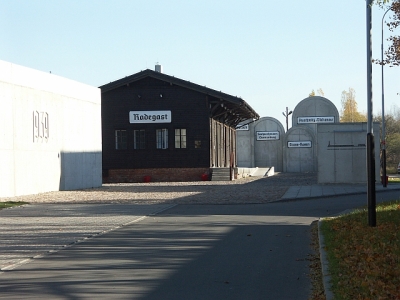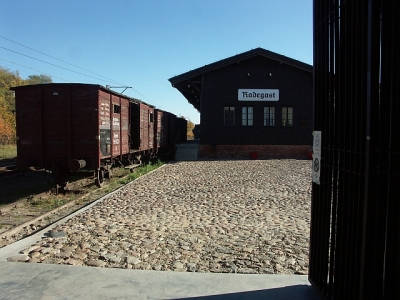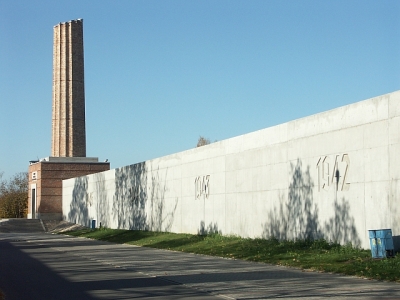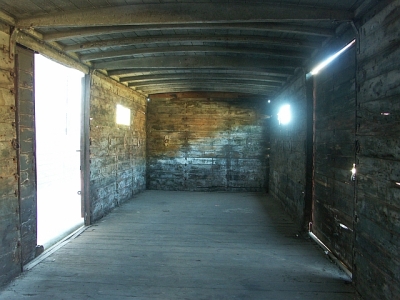 This is one of the most important historical sites connected to the Lodz ghetto. From this place, tens of thousands of people were herded off to the death camp at Chelmno-nad-Nerem in the years 1942-1944 and then to Auschwitz in August 1944. The original wooden building along with its loading platform still stands today.
The railway station was built in 1937. It took on a particular role in April 1940 once the ghetto was sealed off and isolated from all the rest of Lodz. Soon the station and its immediate surroundings were cordoned off with barbed-wire fencing. People living in the neighboring residential area were forced to move out. A guardhouse, warehouses and additional tracks were built.
This is one of the most important historical sites connected to the Lodz ghetto. From this place, tens of thousands of people were herded off to the death camp at Chelmno-nad-Nerem in the years 1942-1944 and then to Auschwitz in August 1944. The original wooden building along with its loading platform still stands today.
The railway station was built in 1937. It took on a particular role in April 1940 once the ghetto was sealed off and isolated from all the rest of Lodz. Soon the station and its immediate surroundings were cordoned off with barbed-wire fencing. People living in the neighboring residential area were forced to move out. A guardhouse, warehouses and additional tracks were built.
Beginning in 1940, food and fuel for the ghetto was shipped in through the Radogoszcz Station, what was commonly called "the loading platform in Marysin." The raw materials necessary for the production of clothes, shoes and uniforms for the German military also arrived here. Ready-made goods then were transported out of the ghetto from this site. Beginning in mid-1940, the ghetto Jews were escorted from the station to labor camps in the Poznan region. They were also led out to construct the rail junction at Lodz-Olechow.
In 1941, transports of Jews and Gypsies from outside of Poland arrived at Radogoszcz Station, what was the port of entry into the Lodz ghetto. Later, waves of Jewish communities were brought in from the liquidated ghettoes of towns and villages in the surrounding region, what the Nazis called the Warta Land.
 Starting in 1942, transports of Jews were sent out from Radogoszcz to their deaths. From the spring to the autumn of 1942, more than 70,000 Jews were sent north to the death camp at Chelmno-nad-Nerem. The transports were suspended for a year and a half, then the mass killing at Chelmno resumed. In June and July of 1944, more than 7,000 people were escorted there. Almost no one survived. Beginning on August 2, 1944, the surviving ghetto inhabitants were transported to Auschwitz. The last transport of ghetto Jews is reported to have left on August 29, 1944. Of the more than 70,000 people deported to Auschwitz during those final days, only a few thousand survived. The figures quoted by historians vary and oscillate between 5,000 and 15,000.
Starting in 1942, transports of Jews were sent out from Radogoszcz to their deaths. From the spring to the autumn of 1942, more than 70,000 Jews were sent north to the death camp at Chelmno-nad-Nerem. The transports were suspended for a year and a half, then the mass killing at Chelmno resumed. In June and July of 1944, more than 7,000 people were escorted there. Almost no one survived. Beginning on August 2, 1944, the surviving ghetto inhabitants were transported to Auschwitz. The last transport of ghetto Jews is reported to have left on August 29, 1944. Of the more than 70,000 people deported to Auschwitz during those final days, only a few thousand survived. The figures quoted by historians vary and oscillate between 5,000 and 15,000.
The Radogoszcz Station was the so-called Umschlagplatz of Lodz, the site where people were assembled just prior to being shipped out, in most cases to die. This modest station building on Stalowa Street marked those final steps, the final moments in the Litzmannstadt Ghetto.
 For years, the building lay in ruin, pretty well forgotten. In 2002, the Monumentum Iudaicum Lodzense Foundation, an organization that helps preserve the Jewish heritage in Lodz, suggested that a museum of the ghetto be created in the Radogoszcz Station building. It is to be one of the major historical sites that tell the tragic story of the Lodz ghetto.
For years, the building lay in ruin, pretty well forgotten. In 2002, the Monumentum Iudaicum Lodzense Foundation, an organization that helps preserve the Jewish heritage in Lodz, suggested that a museum of the ghetto be created in the Radogoszcz Station building. It is to be one of the major historical sites that tell the tragic story of the Lodz ghetto.
On the order of the German authorities, the Construction Department commenced to build large barracks at Radogoszcz Station. The materials are supplied for this purpose, and the work includes only the foundations and assembly of barracks. The space occupied by the barracks is about 900 square meters. The barracks will house depots for materials and semi-finished products supplied to the ghetto. Perhaps there is yet another purpose for those barracks. It is possible that they will be used as assembly point for deportees arriving and leaving. The authorities demanded in the form of an ultimatum that the construction of the barracks be completed this month.
The Chronicle of the Lodz Ghetto, July 11, 1942, Vol. 2, p. 129.
When the gates opened and I went out of the ghetto area, my heart sank. I thought I was lucky to leave. Our way led along the rails. When have I last seen a train? If I could only get a place by the window, from where I could admire the mosaic of fields, woods, small villages, winding streams and cows in pastures... […]
 Shivering from excitement, I walked surrounded by a crowd of people. My uncle, Salek, my aunt and I walked hand in hand. We could already hear the puffing of the engine and see the steam billowing. But what is it? It is not a passenger train approaching us in the steam clouds, but a long line of cattle cars. Each car had a small, barred window. A terrible fright caught me in its claws. I saw the soldiers brutally forcing the people into the train. And only then, for the first time, it flashed through my mind that Salek could have been right: we shouldn't have left the ghetto. But it was already too late. The cattle cars were filled in an orderly fashion. Exactly 32 people in each, irrespective of some child, mother or father left outside. Begging brought no results. The iron door was slid with a clatter and secured with thick bolts; two soldiers sat on the stairs with bayonets.
Shivering from excitement, I walked surrounded by a crowd of people. My uncle, Salek, my aunt and I walked hand in hand. We could already hear the puffing of the engine and see the steam billowing. But what is it? It is not a passenger train approaching us in the steam clouds, but a long line of cattle cars. Each car had a small, barred window. A terrible fright caught me in its claws. I saw the soldiers brutally forcing the people into the train. And only then, for the first time, it flashed through my mind that Salek could have been right: we shouldn't have left the ghetto. But it was already too late. The cattle cars were filled in an orderly fashion. Exactly 32 people in each, irrespective of some child, mother or father left outside. Begging brought no results. The iron door was slid with a clatter and secured with thick bolts; two soldiers sat on the stairs with bayonets.
The train seemed to have no end, and there was a long line of people in front of us. As soon as a car was filled, we proceeded towards the next one. The loading was conducted with lightning speed. As the cars were closed, one after another, the crowd became smaller.
Sara Zyskind, The Stolen Years, p. 161.

 Home
Home
